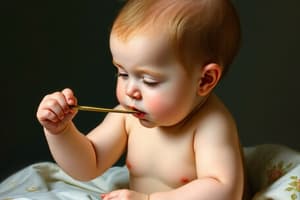Podcast
Questions and Answers
What key aspect of gross motor development should be observed in infants during their first year?
What key aspect of gross motor development should be observed in infants during their first year?
- Crawling begins around 3 months
- Coordination of body movements by 12 months (correct)
- Ability to walk unaided by 6 months
- Jumping by 9 months
Which activity is recommended for sensory stimulation in infants at around 6 months?
Which activity is recommended for sensory stimulation in infants at around 6 months?
- Providing only visual stimuli
- Playing peek-a-boo and pat-a-cake (correct)
- Singing lullabies exclusively
- Reading wordy picture books
What is a common concern parents may have regarding infant safety?
What is a common concern parents may have regarding infant safety?
- Infants' ability to chew food
- How to manage sleep schedules
- Preventing car accidents (correct)
- Establishing verbal communication
What is the primary focus of the oral stage of development in infants?
What is the primary focus of the oral stage of development in infants?
What government strategy can improve infant health effectively?
What government strategy can improve infant health effectively?
What aspect of the child's behavior raises potential concerns for developmental delay?
What aspect of the child's behavior raises potential concerns for developmental delay?
Which of the following vital signs is a cause for concern for the 12-month-old child?
Which of the following vital signs is a cause for concern for the 12-month-old child?
What developmental milestone is the child unable to achieve according to the mother's report?
What developmental milestone is the child unable to achieve according to the mother's report?
Which of the following behaviors suggests a possible communication issue in the child?
Which of the following behaviors suggests a possible communication issue in the child?
What does the assessment reveal regarding the child's growth patterns?
What does the assessment reveal regarding the child's growth patterns?
What major neurological development occurs during the first year of life?
What major neurological development occurs during the first year of life?
At what age is a child expected to have steady head control?
At what age is a child expected to have steady head control?
Which developmental milestone is expected at around 10-12 months?
Which developmental milestone is expected at around 10-12 months?
Which statement accurately describes critical periods in brain development?
Which statement accurately describes critical periods in brain development?
What developmental milestone is typically reached at 10 months?
What developmental milestone is typically reached at 10 months?
What behavior was noted in the 12-month-old child during the assessment?
What behavior was noted in the 12-month-old child during the assessment?
When does the 'moro' reflex typically disappear in infants?
When does the 'moro' reflex typically disappear in infants?
At what age does an infant typically begin to transfer objects from hand to hand?
At what age does an infant typically begin to transfer objects from hand to hand?
Flashcards are hidden until you start studying
Study Notes
Infant Development
- Infancy spans from 1 to 12 months.
- The brain volume doubles in size during the first year of life
- This is due to the development of neural connections, long-range axons, and myelination.
- Critical periods of brain development are prominent during the first year of life, making it crucial for environmental stimulation and adaptive signals for brain development.
- The posterior fontanel closes by 8 weeks (2 months).
- Social smile occurs at 2 months.
- Head turns to locate sounds by 3 months.
- The moro reflex disappears around 4 months.
- Steady head control is achieved by 4 months.
- Rolling from back to side at 4 months.
- Rolling from abdomen to back and back to abdomen occurs at 5-6 months.
- Holding a bottle with two hands at 6 months.
- Transfer objects from hand to hand at 6-7 months.
- Able to sit unsupported at 8 months.
- Crawling at 10 months.
- Walking with assistance at 10-12 months.
- Fine pincer grasp appears at 10-12 months.
- Turn pages of a book at 1 year.
Infant Play
- Sensorimotor stimulation is important by 6 months.
- Peek-a-boo and pat-a-cake are examples of this type of stimulation.
- Body parts are an object of play during this stage.
- Many of the infants' first tasks involve their mouths.
- This stage of life is often referred to as the oral stage of development.
Infant Vital Signs
- Normal heart rate for a 12-month-old is 100-150 beats per minute.
- Normal blood pressure for a 12-month-old is 70-100 systolic and 40-60 diastolic.
- Normal respiratory rate for a 12-month-old is 20-30 breaths per minute.
- Normal axillary temperature for a 12-month-old is 36.5-37.5 degrees Celsius.
- Normal oxygen saturation for a 12-month-old is 95-100 percent.
Case Study:
- The 12-month-old client's vital signs are within the normal range.
- The client is at the 50th percentile for weight and height.
- The client does not make eye contact, minimal facial expressions, unable to smile or laugh.
- The client does not respond to his name and does not make noises.
- He does not engage in play.
- The client's mother is concerned about his developmental milestones compared to his older sister.
- The lack of social interaction, communication, and play should be further assessed.
- The client frequently turning in circles is also concerning and may indicate developmental delays.
Studying That Suits You
Use AI to generate personalized quizzes and flashcards to suit your learning preferences.




